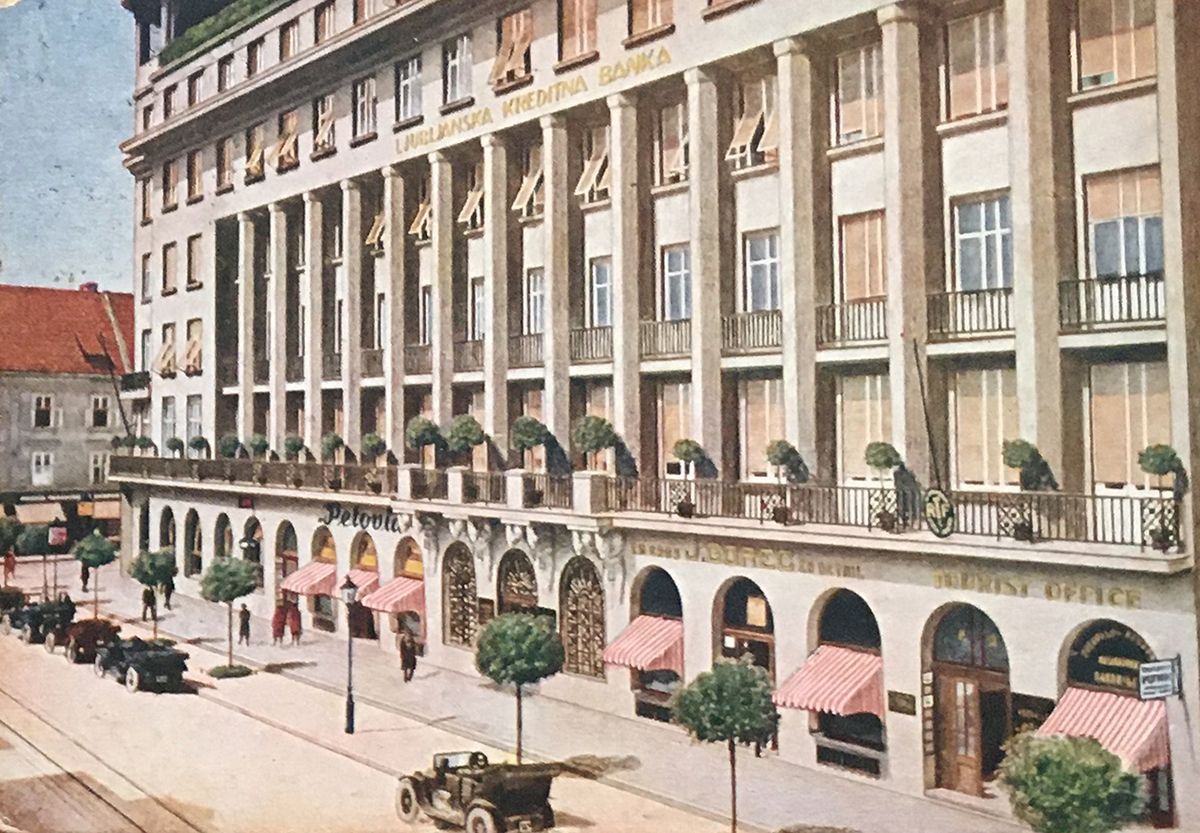
History of the Banka Slovenije building
Ljubljanska kreditna banka (LKB) built its five-storey offices between 1920 and 1923, on what is now the corner of Slovenska and Cankarjeva. Given LKB’s close links at that time with Živnostenská banka in Prague, the bank building was designed by František Krásný, a Czech architect.
The new building with 219 rooms was built in modernist style, and was one of the most advanced buildings in the city at that time: it had central heating, hot water and its own generators, and also had cargo lifts and personal lifts (paternosters), and a ventilation system. The façade on what is now Slovenska was adorned with a large inscription saying Ljubljanska kreditna banka. The display windows were protected against the sun by coloured awning. Trees were planted in beds on the balconies. The surroundings of the building were also decorated with trees.
The main entrance to the building is decorated with four Atlas figures, who support the balcony on the first floor. The Atlases were created by Franc Berneker, a Slovenian sculptor. As repeating elements on the façade, they match the architectural style well.
It was the construction of the LKB building that sparked the modernisation of Ljubljana city centre between the wars. Together with neighbouring financial institutions (banks, savings banks and housing for bank employees), the bank building formed the heart of Ljubljana’s financial quarter.
After the liquidation of LKB in 1947, its premises passed into the hands of the National Bank of Yugoslavia, which gradually began to expand into the as-yet unoccupied spaces, including the former premises of Emona, a coffee house, converting them into more banking premises.
After the establishment of Banka Slovenije on 25 June 1991, the institution fully assumed the role of the central bank of independent Slovenia.
Banka Slovenije has worked with the City of Ljubljana and with the Institute for the Protection of the Cultural Heritage of Slovenia to fully renovate the interior and exterior of the building. The Banka Slovenije building is a cultural monument, and is listed in the register of real estate of the cultural heritage.
Sources:
First, Blaženka: Prestolnica Ljubljana – nekoč in danes; DZS, Ljubljana, 1997
Mrdavšič, Aleksandra: Zrcalo časa v zapisnikih organov Ljubljanske kreditne banke; Archives of the Republic of Slovenia, 1 July 2019, https://www.gov.si/novice/2019-07-01-zrcalo-casa-v-zapisnikih-organov-ljubljanske-kreditne-banke/
Rotovnik, Martin: Nekoč v Ljubljani – Ljubljanska kreditna banka; Delo, 9 April 2015, https://www.delo.si/novice/ljubljana/nekoc-v-ljubljani-ljubljanska-kreditna-banka.html
Zupančič, Bogo: Šelestenje listja pred banko – Ljubljana: Delo XLVII, 82, 9 April 2005, p. 6
Zupančič, Bogo: Usode Ljubljanskih stavb in ljudi 25–48; pp. 72–75.
https://sl.wikipedia.org/wiki/Ivan_Hribar
Štefe, Tomaž: Ivan Hribar – župan, politik, bančnik in diplomat; https://www.kam.si/ivan-hribar/
Damjan, Janez, Žarko Lazarevič: Prvi slovenski bankirji; Finance, April 2011; https://www.finance.si/309117/Prvi-slovenski-bankirji?cctest&
Ljubljanska kreditna banka v Ljubljani (Ljubljanska kreditna banka in Ljubljana, a booklet on the construction of the bank palace); most probably published by Ljubljanska kreditna banka, Ljubljana, 1923?
Aleš Vodopivec: Arhitektura Ljubljane, AB 1978, p. 148
Institute for the Protection of Cultural Heritage, Ljubljana Unit
Banka Slovenije archive

